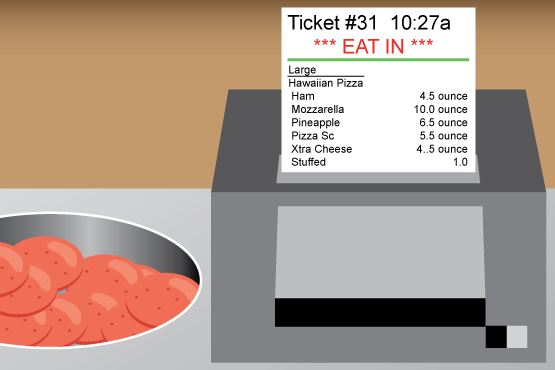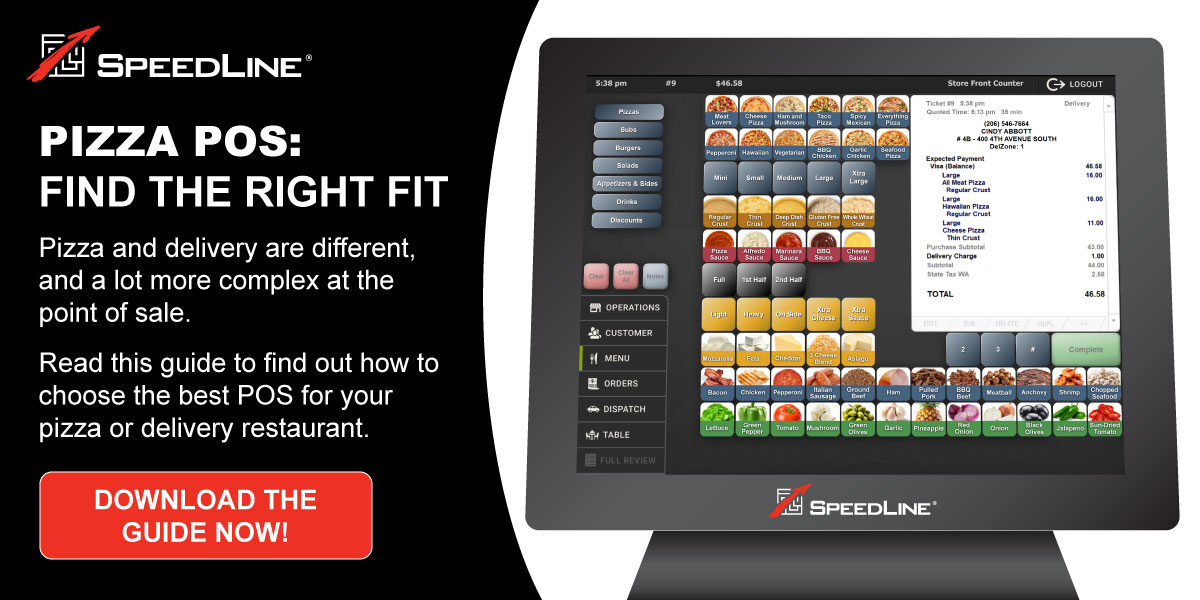Pizzeria margins are slim, so controlling costs is critical to staying profitable. After labor, inventory makes up the bulk of controllable expenses. Waste and over-use of ingredients add up quickly and affect your bottom line. Over-usage can be an invisible profit drain if it isn’t detected and included in your food cost calculations.
Keep Portions Consistent
The first step to reducing over-use is good portion control and a consistent menu that has been properly costed out. Go through your menu and make sure it's been designed with reasonable food costs that will generate a profit. Next, standardize the recipes for every menu item—including create-your-own pizzas.
If you’ve been free-handing your pizza toppings since you opened, now is the time to work out exactly how much of each topping should be on each pizza. Record this as part of the recipe, and update your recipe in your point of sale, and at the makeline.
Weigh and Measure Ingredients
Once you know how much of each topping should be put on a pizza, it’s important to maintain consistency by measuring and weighing the ingredients each and every time. All members of your staff should be doing this, including you. In this article in Pizza Today, Jeffrey Freehof suggests using scales for meat, cups for cheese, and ladles for sauces.
If you find weighing and measuring too time-consuming during the dinner and lunch rushes, add it to your prep plan. Pre-weighing meat during slow times allows you to have accurate portions while speeding up your makeline.
I train all my employees at some point. Our pizza rolls are the best example. We put one ounce of cheese in them. So, I say, "What do you think one ounce of cheese looks like?" And they put it out, and it's never right. It's usually over. And so, I show them an ounce of cheese and I say, "Well, this is what an ounce of cheese costs today. This is the highest I've ever seen cheese cost for an ounce. This is the lowest."
And I say, "When you're making a 16" extra-large pizza, do you think you would notice one extra ounce of cheese?" And they're going to say, "No, probably not." And I say, "What about two?" And they say, "Oh, maybe." I'd say, "Well, you won't. Trust me."
But for the sake of simplicity, let's say you put an extra ounce of cheese on every pizza, and we sell 200 pizzas tonight. How much money is that?" They look at me and they say, "I can't do the math." So, you do it on a calculator. And so I show them what that would be for the night, how much extra money that would cost us. And I say, "Look, nobody is noticing the extra cheese. The customer is never going to know. They're not going to be happy and say, "Oh, thanks for the extra cheese. This is a better pizza. They'll never notice it."
I'm noticing it by losing money. But I usually take that number and I say, "Well, we make, let's say, 100 pizzas. We'll say average it up there throughout the week. Say we sell 100 pizzas today. We put one ounce of extra cheese on there. We usually put two, but just to be nice, I'll say one. And you multiply that by 365 days out of the year, because we're open probably 360 days a year, and show them that number. They'll say, "Oh, that's a lot of money."
- Greg Thomas, owner of Mama Roni's Pizza in Doing More with Less: Dealing with a Labor Shortage
Display Recipes
Make it easy for your staff to see portions for each ingredient. Display a portion chart (a table listing recipes for each pizza type and size) in plain view of your make line.

Add the ingredients directly to the make-ticket. SpeedLine allows you to add the weights and measures of each ingredient for each menu item. That information is then printed on the make-ticket or displayed on your kitchen displays. This is especially useful for create-your-own and half-n-half menu items, which aren’t the easiest to display on a portion chart.
Mike Bausch, owner of Andolini's Pizza in Tulsa, suggested creating videos and detailed charts at the 2019 Pizza Expo. He has a binder with laminated copies of all of his recipes at each location, and ensures the instructions are as detailed as possible, and include photos. He lists how many pepperoni slices should be in each ring on each size pizza, and how much of each topping should be used.
Being overly detailed in instructions and training isn't talking down to your employees. It's ensuring consistency. Everyone has their own way of doing things, but it's the employees' job to ensure each pizza is consistently good.

Prep Plans
Go a step further and reduce waste by using forecasts to develop your daily and weekly prep plan. Prepping too much will lead to spoilage and waste, which leads to profit loss.
Portion Control Isn’t Only Good for the Bottom Line
Consistency isn’t only good for your bottom line—it’s good for your customers too. Over portioning ingredients, especially toppings like cheese and meats, creates false expectations for your customers.
Imagine this situation: A customer comes in and orders a large pepperoni pizza. Your staff are free-handing toppings, and make it with more than the standard amount of cheese, and a little extra pepperoni. The customer eating the pizza assumes the portions are normal. The next time he comes in, perhaps different staff use less cheese and pepperoni. The customer isn’t very happy to pay the same money for less toppings than he got previously, and he may not come back for a third visit.
Stay on Top of Inventory Costs
Portion control is only one part of your inventory management, but it can save you thousands if done properly and maintained. Double-check that your employees are properly following your portion control guidelines from time to time: pull items off the make-line and weigh the key ingredients. If the weights aren’t right, provide more training for your staff.
Monitor your inventory closely, and make use of inventory tracking software. Inventory software integrated with your point of sale system can calculate how much of each ingredient should have been used for each menu item sold. Comparing those numbers with your actual inventory count each week tells you how much inventory you are losing to spoilage, waste, or possible theft.
Posted on Wed, Apr 24, 2019 @ 07:04 AM.
Updated on January 31, 2022 @ 7:38 PM PST.


